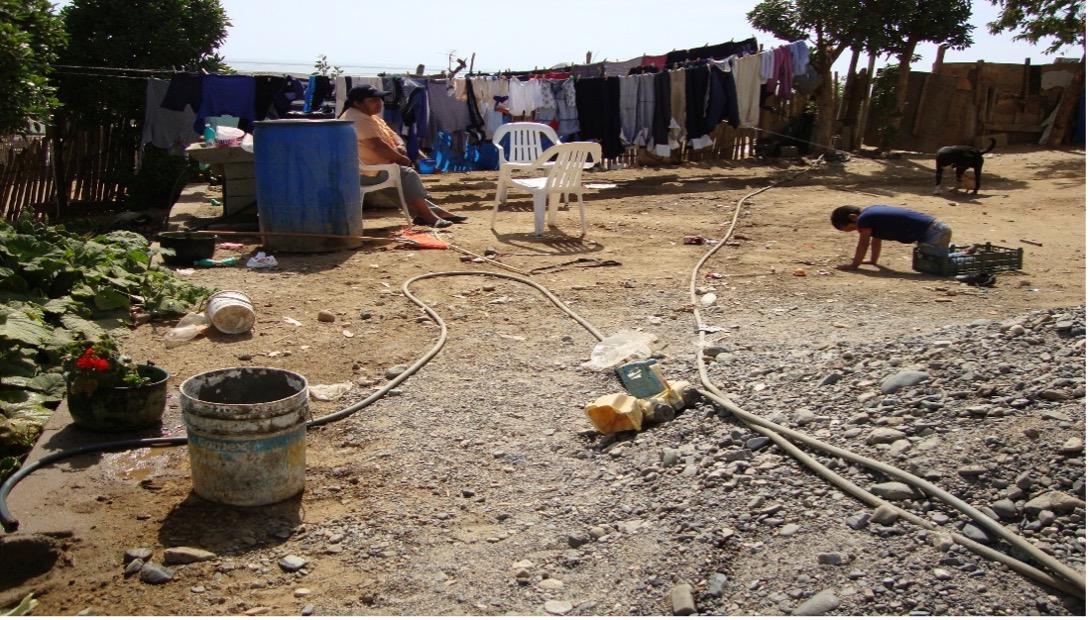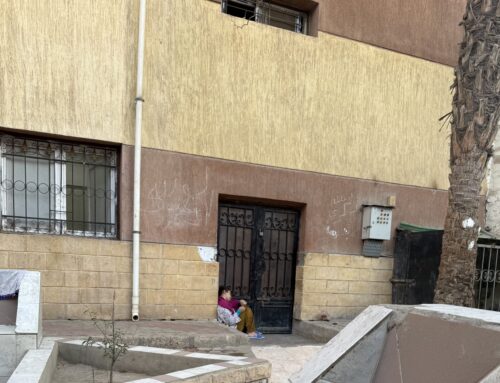On a warm evening in June 2009, residents of a local community in the San Quintin Valley organized a meeting with the head of the Comisión Estatal de Servicios Públicos de Ensenada (CESPE), the regional agency responsible for domestic water distribution. They had gathered to voice their dissatisfaction and to seek solutions to the water problems they were experiencing.
Despite having piped water—a relative privilege in comparison to many other communities in the valley—residents had grown increasingly concerned about the irregularity and unpredictability of water delivery to their homes. Soon after the meeting began, the forty or so attendees began expressing their frustration. One person complained, “We only get water every third day, but CESPE charges us for the service as if we were getting water every day.” Another added, “We are the ones suffering the consequences of CESPE’s action because there are times when four and five days go by without getting water at home.”
As more hands went up, the mood in the room grew tense. Jorge de León, a middle-aged resident, stood and said: “Lack of access to water has become a major social problem here, and the government tries to address it with Band- Aids instead of long-term solutions. We want the government to regulate the water extracted in agricultural wells that are overexploited by large agricultural companies.”
After the head of CESPE departed, many residents lingered, gathering in small groups to continue the discussion. Jorge elaborated his earlier remarks, pointing out that while large agribusinesses had installed their own desalination plants, the local government had failed to build even one for residents—despite the possibility, he argued, of funding such a plant through “a state tax for companies exporting tomatoes.”
This ethnographic vignette reflects the problem of water inequality in the San Quintin Valley of Baja California, one of Mexico’s most important agribusiness export enclaves. The North American Free Trade Agreement (NAFTA), implemented in 1994, enabled agribusiness expansion by making productive resources more accessible and sustaining cross-national trade, thereby supporting year-round sales of crops that are otherwise seasonally restricted. One of the most significant consequences of this expansion has been the overextraction of water to support agribusiness, which has meant chronic water scarcity for the very people working in its fields. While often overlooked in mainstream coverage of the trade regime established by NAFTA and continued under the United States Mexico Canada Agreement (USCMA), anthropological research in the region highlights how these policies have entrenched water inequality, creating new barriers for working people.
Export-oriented agriculture in San Quintin began in the 1970s, when the Mexican government paved the trans-peninsular highway, connecting the valley to U.S. markets. However, it was the neoliberal reforms tied to NAFTA’s implementation in 1994 that spurred the industry’s most significant boom. As part of a structural adjustment program mandated by the International Monetary Fund to secure access to international financing, the Mexican government shifted agricultural subsidies away from smallholders and toward export-oriented agribusinesses, privatized land and water rights, and suppressed organized labor unions.
These reforms attracted multinational agribusiness corporations, which recognized the opportunity to secure year-round sales of fresh fruits and vegetables previously restricted to seasonal cycles. California-based Driscoll’s, for instance, grew to a $3 billion valuation by dominating both inputs–through patented strawberry plant varieties—and outputs, controlling sales via subcontracted production and transportation (Fischer-Daly 2023). To manage its global supply chains, Driscoll’s owners established Reiter Affiliated Companies (RAC), which in 1991 incorporated Berrymex, now the leading berry production company in Mexico. At the time, the Driscoll CEO remarked, “We have developed and patented our own plant varieties, and would not have risked bringing them to Mexico unless NAFTA protected our patents” (Crawford 1997; see also NAFTA chap. 17; USMCA chap. 20).
The expansion of export agriculture in San Quintin fueled a water extraction regime dominated by agribusiness. Initially, companies relied on the valley’s underground aquifers, channeling water through furrow irrigations systems to support large-scale tomato production. By the late 1990s, however, this approach extracted water at six times the natural replenishment rate of the region’s aquifers (Aguirre-Muñoz et al. 2001). In response to mounting scarcity, agribusiness adopted drip irrigation and shade-growing techniques, backed by generous government subsidies. Yet companies simultaneously shifted production from tomatoes to berries, a crop with high-water demands. The rapid intensification of berry cultivation largely offset the purported conservation benefits. Between 2000 and the mid-2010s, the value of Mexico’s berry exports increased 125-fold, with a quarter of this production originating from the increasingly desiccated San Quintin Valley.
Regulatory shifts under Mexico’s export-oriented development model further facilitated agribusiness’s privileged access to water. In preparation for NAFTA, the 1992 National Water Law privatized water rights, decentralizing management of water services to companies and reducing governmental oversight (Whiteford and Melville 2002). When the National Water Commission stopped granting permits for new wells, agribusinesses redirected their strategies, tapping mountain springs and, as stream beds ran dry, investing heavily in desalinization plants (Zlolniski 2011). Rather than addressing corporate overextraction, the government subsidized their efforts, enabling the establishment of a new infrastructure of private water production. By 2020, San Quintin hosted approximately 54 privately owned desalinization plants, collectively treating nearly half of the valley’s agricultural water.
The effects of this system reflect the broader NAFTA-driven regime: while desalination increased water availability in San Quintin, 93 percent of all water in the valley is consumed by agribusiness, overwhelmingly for export (Riemann 2015, 21). Moreover, the desalinization process itself intensified erosion and desertification. All but two of the plants desalinate groundwater drawn directly from the already overextracted aquifer, which has become increasingly infiltrated with seawater (Narshi et. al., 2020).

Figure 1. Desalinization plants of agribusinesses along the Pacific coast, San Quintin, Baja California, Mexico (Photo by Matthew Fischer-Daly, 2020)
In sharp contrast to the lush, irrigated strawberry fields, working class communities—most of whose members are employed in export agribusiness—endure severe water scarcity in San Quintin. Many households suffer from low access to water at high cost. “At times they deliver water two or three times a month, but the bills arrive as if you had water daily,” explained a fieldworker and San Quintin resident, referring to the private companies that residents must pay to fill cisterns, commonly spending half a day’s pay each week on water. The hardships of accessing water to meet their most basic needs have also transformed people’s notions about water itself.
Local residents expressed ambivalent views about water rights, ranging from water as a universal gift of nature to seeing it as a limited resource that needs to be protected. Reflecting the tension, Celeste Hernández, a farmworker in the region, explained:
“When God gives us water it’s for everybody; God never deprives anybody of water but gives it out evenly to all people. . . . My sister, uncles, and other relatives, though, live in Colonia Ampliación [with no piped water], and it hurts to know they do not get water; it’s sad. I know what it is like not having water at home to wash the dishes, bathe our children and oneself. But the majority of people in Arbolitos [where she lives] don’t want water from our well to be taken away.”
Celeste’s narrative illustrates how water scarcity triggers what Ennis McMillan (2001) calls “water suffering”—an emotional perception of the political and structural conditions underpinning the struggle for this basic resource (Zlolniski 2019, 199-200).
In response to the inequality of water distribution, workers in the region have developed ingenious water-saving strategies. One of the most common, used primarily by women, involves recycling laundry water to clean their homes and water their gardens, a practice known as “water multitasking” (Webb and Iskandarani 1998, 5). After washing their families’ clothes, women pour the used water into separate barrels for later use. Far from being an isolated phenomenon, the use of so-called gray water is widespread among the people of San Quintín, including Indigenous Triquis (López 2017, 195). Like growers in the region, residents have learned to use water with great efficiency. But unlike the growers, who extract as much water as possible for irrigation, workers are compelled to be thrifty in their usage, as they must pay for every drop they consume.

Figure 2. Residents getting water in the Vicente Guerrero Delegation in San Quintin (Photo by Christian Zlolniski)
Agro-export industry’s privileged access to water has deepened the processes of water dispossession of farmworkers in northern Mexico, (re)producing economic and social inequality (Fischer-Daly and Zlolniski 2025). It has reduced people’s capacity to drink, bathe, cook, and clean while tightening their dependence on wages and the private sector for access to water at a time when San Quintin has experienced a major economic boom driven by water-intensive export-agriculture. Conceptualizing dispossession as the separation of people from the means of satisfying human needs also highlights the role of the state facilitating the provision of water to exporting agribusinesses at the expense of residents.
The Mexican government, with ample support from the United States and Canada, asserted its unique capabilities to empower multinational corporations. NAFTA entrenched this neoliberal orientation of the Mexican state, most notoriously with a dispute resolution system available only to companies and the signatory states. While the scarcity of water calls into question the material sustainability of export-agriculture, recognizing the phenomenon’s embeddedness in a political structure insulated from democratic institutions showcases its broader social and political implications.
While the USMCA has replaced NAFTA, water inequality continues. Without significant changes to the trade rules and corporate protections established in NAFTA, the USMCA continues supporting agribusiness growth and attendant social inequality. Driscoll’s, for one, has continued expansion in Mexico and reported thirty years of 15 percent annual sales growth (Clements 2021). While such readily available economic data indicate the business benefits of the NAFTA/USCMA regime, understanding its lived experience requires continued ethnographic research in impacted communities such as San Quintin.
References
Aguirre-Muñoz, Alfonso, Robert W. Buddemeier, Victor Camacho-Ibar, José D. Carriquiry, Silvia E. Ibarra-Obando, Barbara W. Massey, Stephen V. Smith, and Fredrik Wulff. 2001. “Sustainability of Coastal Resource Use in San Quintin, Mexico.” Ambio 30(3): 142–49.
Clements, Michal. 2021. “Growth Strategy Case Study: Driscoll’s Berries.” Insight to Action. Accessed August 26, 2025.
Crawford, Leslie. 1997. “New Pioneers Plough Ahead in Mexico: NAFTA’s Freer Trade Is Promising Fruitful Returns to Farm Investors.” Financial Times, June 25, 1997.
Ennis-McMillan, Michael C. 2001. “Suffering from Water: Social Origins of Bodily Distress in a Mexican Community.” Medical Anthropology Quarterly 15(3): 368–90.
Fischer-Daly, Matthew. 2023. International Trade, Labor Relations, and Bargaining Power: International Strawberry Commodity Networks. New York: Routledge Taylor & Francis Group.
Fischer-Daly, Matthew and Christian Zlolniski. 2025. “Export Agribusiness, Multimodal Dispossession, and Livelihood Reconstitution in Baja California.” Mexican Studies Estudios Mexicanos 41(1): 7-33.
Holder, Curtis. 2006. “Contested Visions: Technology Transfer, Water Resources, and Social Capital in Chilasco, Guatemala.” Comparative Technology Transfer and Society 4(3): 269–86.
López, Marcos. 2017. “In Hidden View: How Water Became a Catalyst for Indigenous Farmworker Resistance in Baja California, Mexico.” In The Politics of Fresh Water: Access, Conflict, and Identity, edited by Catherine M. Ashcraft and Tamar Mayer, 188–202. London: Routledge.
Narchi, Nemer, et al. 2020. “Environmental Violence and the Socio-environmental (De)Evolution of a Landscape in the San Quintín Valley.” Latin American Perspectives 47(6): 103–18.
Riemann, Hugo. 2015. “La región agrícola Camalú–El Rosario y sus recursos hídricos.” In El agua en la región agrícola Camalú–El Rosario, Baja California, edited by Hugo Riemann, 11–28. Puebla: Editorial de la Red Nacional de Investigación Urbana (RNIU).
Velasco, Laura, Christian Zlolniski, and Marie-Laure Coubès. 2014. De jornaleros a colonos: Residencia, trabajo e identidad en el valle de San Quintín. Tijuana: El Colegio de la Frontera Norte.
Webb, Patrick, and María Iskandarani. 1998. “Water Insecurity and the Poor: Issues and Research Needs.” Paper presented at the Center for Development Research on Development Policy, Bonn, October.
Whiteford, Scott, and Robert Melville, eds. 2002. Protecting a Sacred Gift: Water and Social Change in Mexico. Vol. 19. San Diego: Center for U.S.–Mexican Studies, University of California, San Diego.
Zlolniski, Christian. 2011. “Water Flowing North of the Border: Export Agriculture and Water Politics in a Rural Community in Baja California.” Cultural Anthropology 26(4): 565–88.
———. 2019. Made in Baja: The Lives of People Behind Mexico’s Transnational Agricultural Boom. Oakland: University of California Press.
Matthew Fischer-Daly is a labor researcher and educator, currently a Lecturer at Rutgers University School of Management and Labor Relations. His research focuses on workers’ rights in the international political economy. He is the author of International Trade, Labor Relations, and Bargaining Power International Strawberry Commodity Networks (Routledge 2023), and holds a PhD in industrial and labor relations from Cornell University and an MA in International Economic Relations from American University.
Christian Zlolniski is Professor of anthropology at the University of Texas at Arlington (UTA). His research interests focus on economic globalization, work, and transnational migration, with regional focus on the U.S.-Mexico border. He is the author of Made in Baja: The Lives of Farmworkers and Growers behind Mexico’s Transnational Agricultural Boom (University of California Press 2019). Between 2020 and March 2025, he served as chief editor of the journal Mexican Studies/ Estudios Mexicanos published by University of California Press.
Cite as: Fischer-Daly, Matthew, and Christian Zlolniski. 2025. “Agribusiness Grows and Society Thirsts in Northwestern Mexico”. In “Anthropology of Free Trade”, edited by Alejandra González Jiménez, American Ethnologist website, 11 November. [https://americanethnologist.org/online-content/agribusiness-grows-and-society-thirsts-in-northwestern-mexico-by-christian-zlolniski-and-matthew-fischer-daly/]
This piece was edited by American Ethnological Society Digital Content Editor Katie Kilroy-Marac (katie.kilroy.marac@utoronto.ca).




